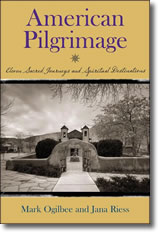When
we become pilgrims, we become boundary-crossers, slipping
out beyond our normal borders and limitations to other,
more
spiritual realms. —American
Pilgrimage
 Sometimes
a trip seems insufficient, especially when you want more
than souvenirs and destination snapshots.
A pilgrimage is a journey of a different kind, one focusing on
self-reflection, discovery and transformation. Sometimes
a trip seems insufficient, especially when you want more
than souvenirs and destination snapshots.
A pilgrimage is a journey of a different kind, one focusing on
self-reflection, discovery and transformation.
In
their new book, American Pilgrimage, Mark
Ogilbee and Jana Riess
crisscross America exploring pilgrimage sites
as diverse as The Community of Jesus in Cape Cod, Massachusetts,
and Elvis
Presley's Graceland in Memphis, Tennessee. They write about places
from which they left changed, places that offer a chance for
stepping closer to God.
The
excerpt below is but one of their sacred journeys—a pilgrimage
to the inspiring landscape of Sedona, Arizona.
The Mountains are Singing:
Beauty and Devotion among the Red Rocks
Sedona, Arizona
by Mark Ogilbee and Jana Riess
Show Page: 1 2 3 4 | next Hundreds of millions of years ago, central Arizona was wet. Shallow seas and river deltas, flood plains and coastal sand dunes variously marked the landscape. Sediment and sand accumulated, was buried under more sediment and sand, and over time hardened into limestone, sandstone, and other types of rock. Fast-forward to just a few million years ago when tremendous geologic forces activated faults and other weaknesses in those rocks. Eventually, through the steady work of wind and water, these weaknesses eroded into canyons and valleys, leaving behind uneroded, often massive, stratified red rock formations in what by then had become a desert land.
Today, as travelers drive the road south from Flagstaff toward Sedona, they descend some 2,500 feet into one such eroded canyon—Oak Creek Canyon, lush with trees—and down through successively older layers of the rock; as you drive down to Sedona, you simultaneously drive backward through eons of geologic time. When the road reaches the canyon's mouth, the trees suddenly stop, and the view opens to a dramatic desert panorama: fantastically high buttes, spires, and mesas, each composed of distinct horizontal strata, like layers of a cake, ranging from sandy-light to fiery orange to burnt ochre to rich, deep shades of brownorange-red that defy description. In one glance, these strata, the telltale sign of sedimentary rock, bear witness to tens of millions of years of blowing sand dunes, lost rivers, and disappeared seas.
Come to Sedona, and the beauty of these desert silent rocks will astonish you.
Deserts have long been conducive to spiritual experiences. Perhaps it's the starkness, which stills our minds and enables us to behold the holy all about us. Maybe it's the dryness, which creates thirst and reminds us that we are not physically, or spiritually, self-sufficient after all. Or perhaps it's just the sheer magnitude of the dry bare earth from horizon to horizon, speaking clearly of the trajectory of our lives: From dust we come and to dust we will return.
Whatever the reason, the desert landscape in and around Sedona is sublime, as travelers and pilgrims have been discovering for more than a century. Today, some four million people visit “red rock country” annually, of which (according to a Northern Arizona University study) almost two-thirds are seeking a spiritual experience. They come to Sedona for peace, solace, revelation, transformation. They are pilgrims in the wilderness.
Yet Sedona is a fascinating and uniquely American pilgrimage destination because it does not appeal to pilgrims of one faith only. Go up into the red rocks and you will find fundamentalists and skeptics, seekers and self-proclaimed heretics, each seeking to encounter the holy according to his or her understanding. Some discover it in and near the rocks themselves. Others find inspiration in an Easter sunrise worship service at a mesa-top shrine dedicated to inter-religious cooperation. Still others find it by lighting candles and praying in the Chapel of the Holy Cross, a Catholic sanctuary built strikingly on a promontory as if the finger of God had drawn it up from the very rocks themselves.
But whatever their differences, these pilgrims are united in their common experience of the sheer beauty of the Sedona landscape. They may describe the experience differently, but they all agree on one thing: The magnificent vistas and rugged red rocks aren't just an opportunity for a pretty picture. The beauty here is something you encounter; it's a power that invites you, whatever your faith, to slow down and alter your established patterns of thinking and acting in the world. The experience of beauty may be subjective, but one thing is certain: In Sedona, at least, the beauty can change your perspective entirely.
Show Page: 1 2 3 4 | next
Copyright ©2006 Mark Ogilbee and Jana Riess
Reprinted from AMERICAN PILIGRIMAGE: ELEVEN SACRED JOURNEYS AND SPIRITUAL DESTINATIONS published by Paraclete Press, May 2006.

To purchase a copy of AMERICAN PILGRIMAGE, visit amazon.com. This link is provided as a service to explorefaith visitors and registered users.
|




